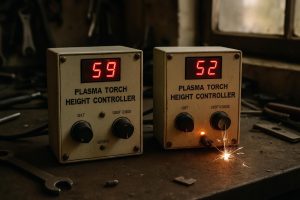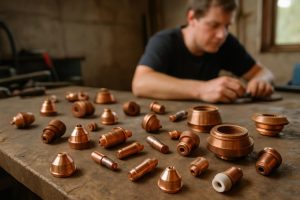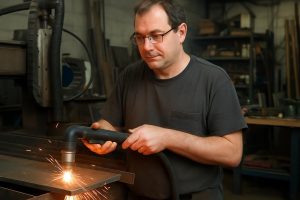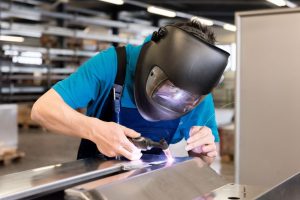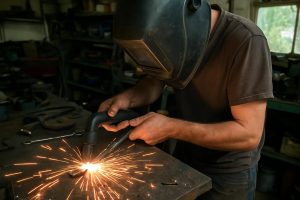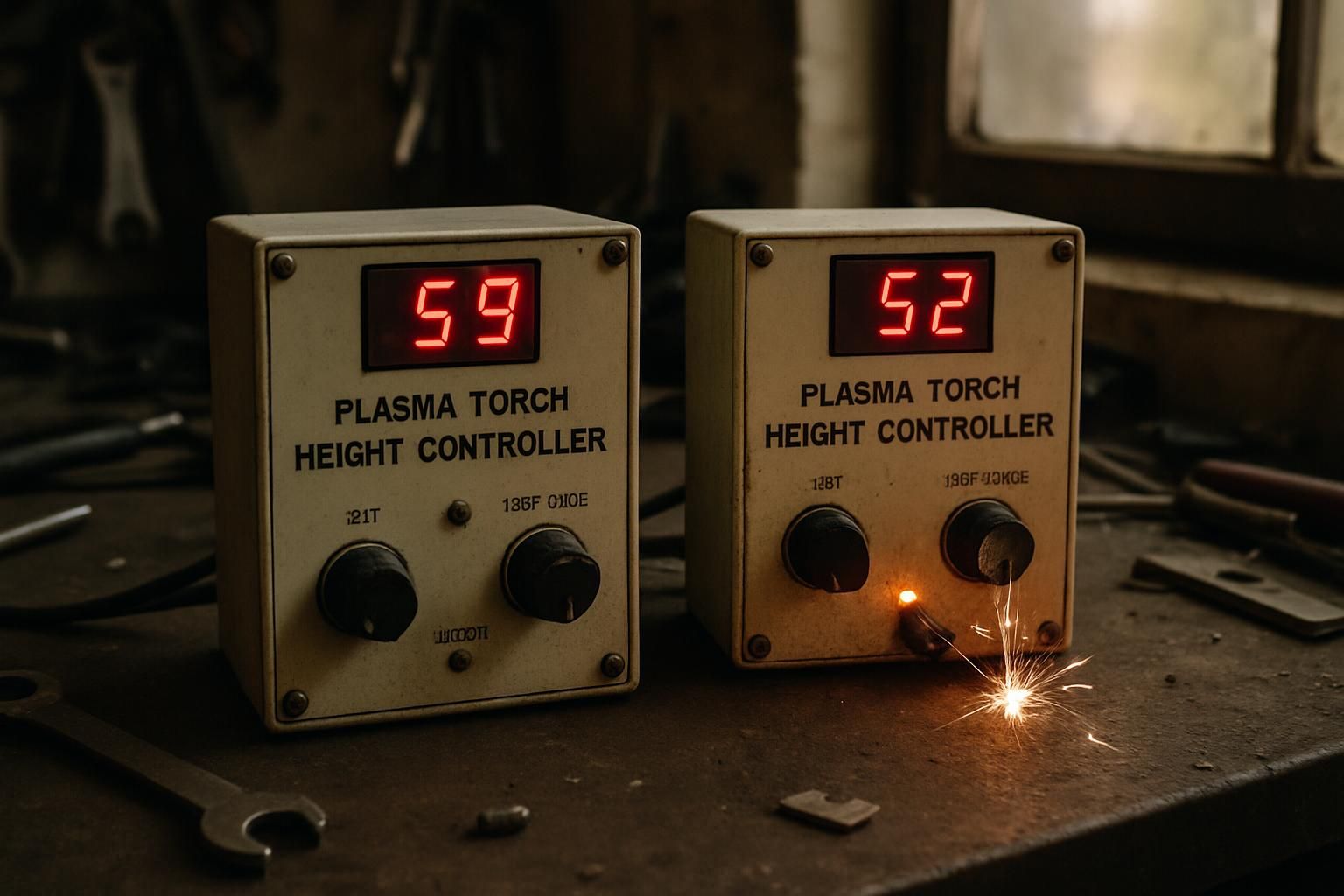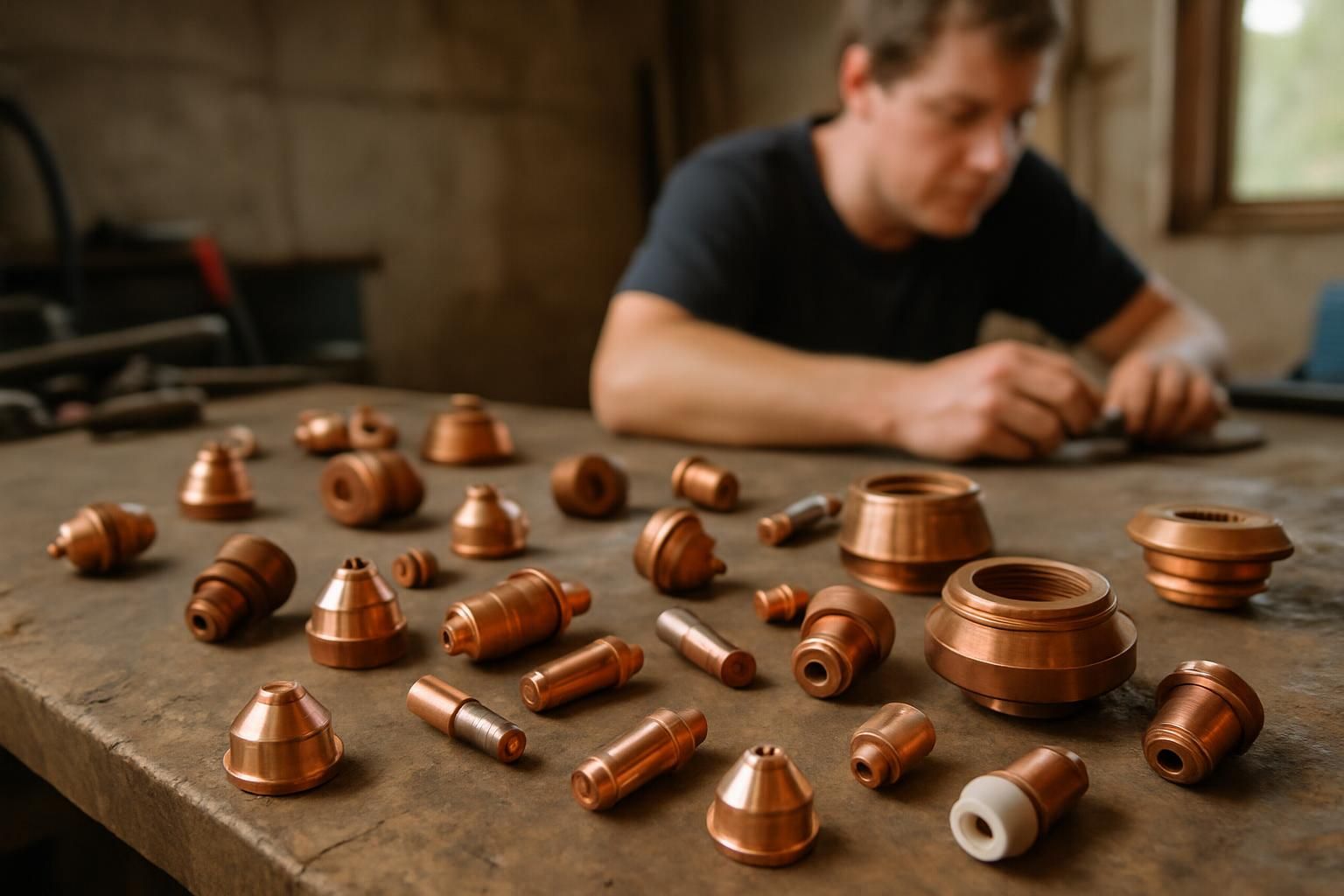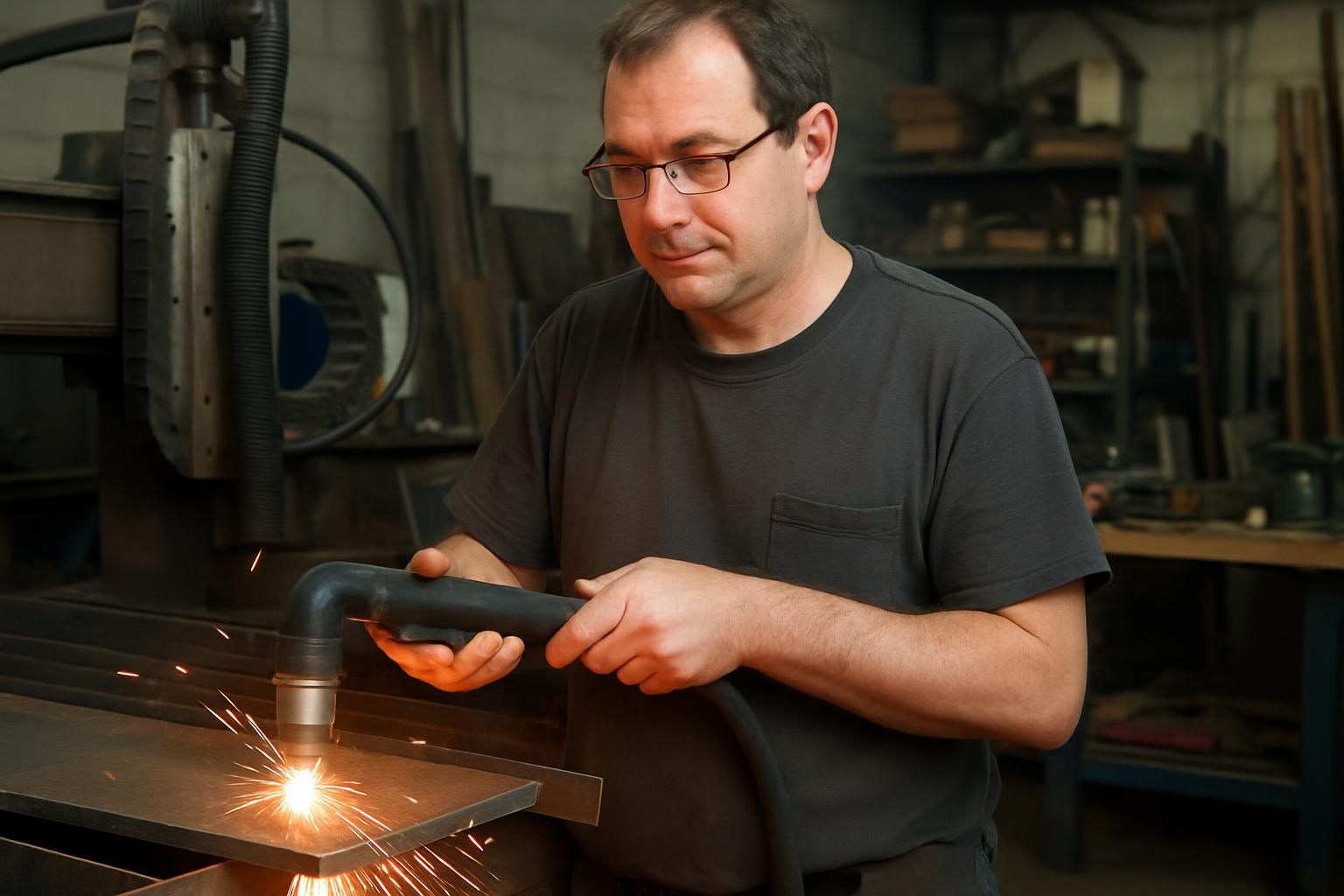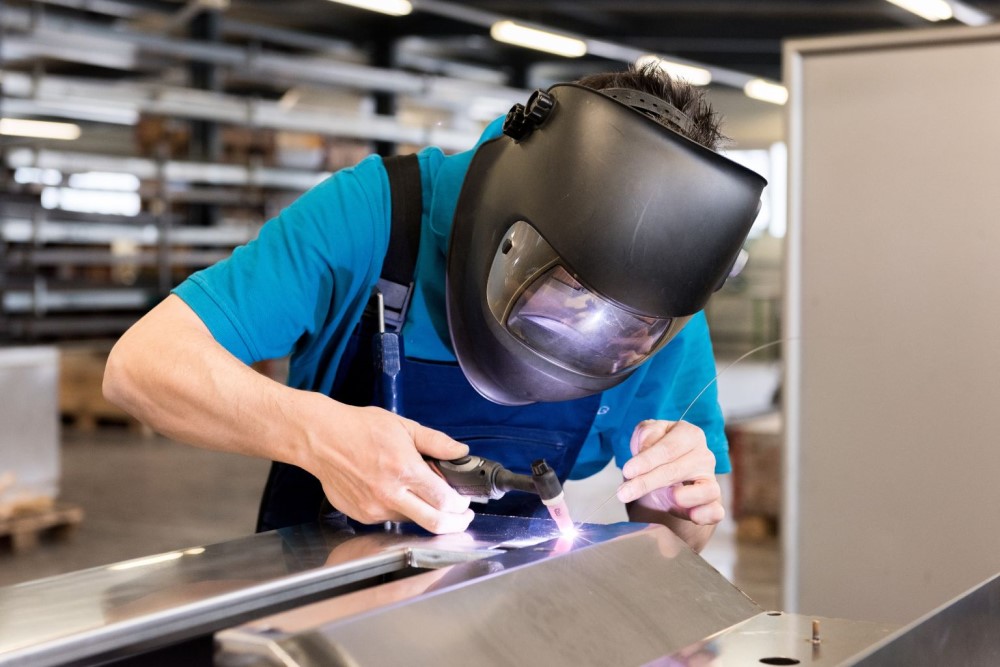Plasma cutters are powerful tools for slicing through metal, but their efficiency depends on one crucial factor – consumables. These parts wear out over time and need replacing. But how long do they really last?

The lifespan of plasma cutter consumables typically ranges from 1 to 3 hours of actual cutting time, depending on factors like amperage, material thickness, and cutting technique. We’ve found that proper care and maintenance can significantly extend this lifespan, saving you time and money in the long run.
Choosing the right consumables and using them correctly are key to getting the most out of your plasma cutter. We’ll explore some practical tips to help you maximize the life of your consumables and improve your cutting quality.
キーテイクアウト
- Plasma cutter consumables usually last 1-3 hours of cutting time
- Proper care and technique can extend consumable lifespan
- Choosing quality consumables improves cutting performance and efficiency
What Are Plasma Cutter Consumables?
Plasma cutter consumables are essential parts that wear out over time and need regular replacement. We’ll explore the key components, their functions, and why they matter for plasma cutting.
Definition And Core Components
Plasma cutter consumables are the parts that directly contact the plasma arc and workpiece during cutting. The main components include:
- 電極: A copper or hafnium-tipped rod that conducts electricity
- ノズル: A copper piece with a small hole that focuses the plasma arc
- Swirl ring: A plastic or ceramic ring that creates a swirling effect for the plasma gas
- シールドキャップ: An outer protective piece that helps direct the plasma stream
These parts work together to create and control the plasma arc for precise cutting. They’re called “消耗品” because they gradually wear down and require replacement to maintain cutting quality.
Function Of Each Component
Let’s break down what each consumable does:
- Electrode: Emits electrons to start and maintain the plasma arc
- Nozzle: Constricts and focuses the plasma arc for accurate cutting
- Swirl ring: Creates a vortex of gas around the electrode for cooler operation
- Shield cap: Protects other consumables and improves cut quality
The electrode and nozzle bear the brunt of the heat and wear. The swirl ring helps extend their life by cooling them. The shield cap acts as a barrier, protecting the other parts from spatter and heat.
Importance In Plasma Cutting Process
Plasma cutter consumables play a crucial role in the cutting process. They directly impact:
- Cut quality: Fresh consumables produce cleaner, more precise cuts
- Cutting speed: Well-maintained parts allow for faster cutting
- Operating costs: Longer-lasting consumables reduce replacement frequency
Proper care of these components can significantly extend their lifespan. Regular inspection and timely replacement ensure consistent performance and cut quality. Using the right consumables for your specific plasma cutter model is also crucial for optimal results.
By understanding these parts, we can better maintain our plasma cutters and achieve better cutting outcomes. It’s a small investment that pays off in improved efficiency and cut quality.
Key Factors Impacting Consumable Lifespan
Several elements play a crucial role in determining how long plasma cutter consumables last. We’ll explore the main factors that affect their lifespan and how to get the most out of these important components.
Cutting Parameters And Techniques
The way we use our plasma cutter greatly impacts consumable life. Proper pierce height is very important for extending the life of consumables. We need to set the right cutting speed and amperage for each job.
Too high amperage can wear out parts faster. Cutting too slowly can also cause extra wear. We should always match our settings to the material thickness.
Starting and stopping cuts properly helps too. Ramping up power slowly at the start and tapering off at the end reduces stress on consumables.
Material Characteristics
Different metals affect consumable life in various ways. Softer metals like aluminum are easier on parts than harder steels.
Thicker materials require more power and time to cut. This puts extra strain on consumables. We should use higher-rated consumables for thicker cuts.
Rusty or painted surfaces can be tough on consumables too. Cleaning materials before cutting helps extend part life.
Some alloys produce more dross, which can damage consumables. We need to be extra careful with these materials.
環境条件
Where and how we cut affects our consumables. Dusty or humid environments can shorten their lifespan.
Extreme temperatures are hard on plasma cutter parts. We should try to work in moderate conditions when possible.
Wind can disrupt the plasma arc, causing uneven wear. Using wind shields helps protect consumables outdoors.
Proper storage matters too. Keeping consumables clean and dry when not in use helps them last longer.
Air Quality And System Maintenance
Clean, dry air is crucial for plasma cutting. Moisture or contaminants in the air supply can quickly damage consumables.
We should use high-quality air filters and dryers. Checking and replacing these regularly is key.
Proper torch maintenance is also vital. We need to clean and inspect the torch often.
Coolant quality affects consumable life in water-cooled systems. We must change coolant as recommended by the manufacturer.
Regular system checks help catch issues early. This prevents unnecessary wear on consumables.
Typical Lifespan Of Plasma Cutter Consumables

Plasma cutter consumables have varying lifespans depending on the component and usage conditions. Let’s explore the typical longevity of key parts and factors that influence their durability.
Detailed Breakdown By Component
The main consumables in a plasma cutter include:
- 電極: These typically last 1-2 hours of actual cutting time. Electrodes with hafnium tips tend to have a longer lifespan.
- ノズル: We expect nozzles to last about 1-3 hours of cutting time. Their life is closely tied to electrode wear.
- 渦巻きリング: These can last 5-10 hours, depending on how well we maintain them.
- Retaining caps: With proper care, these can last 20-30 hours.
- シールドキャップ: These are the most durable, often lasting 40-60 hours or more.
We should note that these are average figures. Actual lifespan can vary based on our cutting techniques and machine settings.
Average Hours Of Operation
On average, we can expect a set of plasma cutter consumables to last about 3-5 hours of actual arc-on time. This translates to roughly:
- 300-500 starts for hand-held systems
- 1000-1500 starts for automated systems
We find that automated systems tend to have longer consumable life due to consistent operation and controlled piercing.
It’s crucial to track arc-on time rather than total machine runtime. This gives us a more accurate picture of consumable usage.
Variability Based On Usage Conditions
Several factors can affect the lifespan of our consumables:
- 切断アンペア: Higher amperages wear consumables faster.
- 材料の厚さ: Thicker materials require more power, increasing wear.
- 切断速度: Too slow or too fast can both reduce consumable life.
- Air quality: Clean, dry air helps extend consumable life.
- Piercing frequency: More piercing leads to faster wear.
私たちはそれが適切であることがわかりました machine maintenance and operator technique can significantly extend consumable life. Regular cleaning and inspection are key to getting the most out of our parts.
By understanding these factors, we can optimize our cutting processes and get the most value from our consumables.
Practical Strategies To Extend Consumable Life

Extending the life of plasma cutter consumables saves money and improves cutting quality. Let’s explore some key strategies to get the most out of these essential components.
Optimal Cutting Techniques
To maximize consumable life, we need to focus on proper cutting techniques. Start by setting the correct amperage and gas pressure for each job. Too high amperage can wear out consumables faster.
We recommend:
- Using the right torch height
- Maintaining a consistent travel speed
- Avoiding excessive piercing
Proper gas selection is crucial. For steel, we use oxygen as the plasma gas and air as the shield gas. This combo gives a good cut quality and extends consumable life.
Don’t drag the torch on the metal. Keep a small gap between the torch and workpiece. This prevents damage to the consumables.
Proper Equipment Maintenance
Regular maintenance is key to longer consumable life. We always clean our torch after each use. This removes spatter and debris that can cause wear.
Here’s our maintenance checklist:
- Check O-rings and seals weekly
- Clean air filter monthly
- Inspect coolant levels (for water-cooled systems)
- 電気接続を締めます
We also make sure to use the right consumables for our specific torch model. Mixing and matching parts can lead to poor performance and shorter life.
Don’t forget about your air compressor. Clean, dry air is essential for consumable longevity.
Regular Inspection And Proactive Replacement
We inspect our consumables before each use. Look for signs of wear like:
- Pitting on the electrode tip
- Widening of the nozzle orifice
- Damage to the swirl ring
Don’t wait for complete failure. Replace parts proactively when you notice decreased cut quality. This prevents damage to other components.
Tracking consumable life helps us plan replacements. We keep a log of hours used for each part. This lets us predict when replacements are needed.
Remember, electrodes and nozzles wear as a set. Always replace them together for best results.
Quality Of Consumables And Equipment
We only use high-quality, genuine consumables. Cheap knock-offs might save money upfront but cost more in the long run. They wear out faster and can damage your torch.
Our tips for choosing consumables:
- Buy from reputable suppliers (Weicheng is the leading plasma consumables in China))
- Check for proper certifications
- Look for advanced materials like hafnium-tipped electrodes
Investing in a quality plasma cutter pays off. Better machines have more consistent arc starts and stops. This reduces wear on consumables.
We also use a CNC cutting table when possible. It provides smoother, more consistent cuts than hand-held torches. This leads to longer consumable life.
Troubleshooting Common Consumable Issues

Plasma cutter consumables can face various issues that affect their performance and lifespan. Let’s explore how to identify and address these problems to keep your cutting system running smoothly.
Signs Of Wear And Degradation
We often see worn consumable parts causing trouble in plasma cutting systems. Look for these telltale signs:
- Discoloration or melting on the electrode tip
- Widened or irregular orifice in the nozzle
- Pitting or erosion on the swirl ring
- Cracks or chips in the shield cap
These issues can lead to poor cut quality and reduced efficiency. We recommend checking your consumables regularly, ideally before each use.
Performance Indicators
When consumables start to fail, we notice changes in cutting performance. Keep an eye out for:
- Inconsistent arc start or difficulty initiating cuts
- 切断速度の低下
- ドロス形成の増加
- Angled or rough cut edges
Poor consumable life can also result in more frequent misfires or pilot arc failures. If you spot these issues, it’s time to investigate your consumables.
Diagnostic Techniques
We use several methods to diagnose consumable problems:
- Visual inspection: Examine each part closely for wear.
- Resistance testing: Check for proper electrical connections.
- Air flow test: Ensure proper gas flow through the system.
- Trial cuts: Make test cuts on scrap material to assess performance.
It’s crucial to use a systematic approach when troubleshooting. This helps identify the root cause quickly.
When And How To Replace Components
We always stress the importance of timely replacements. Here’s our guide:
- Replace electrodes when the pit depth exceeds 1.5mm
- Change nozzles if the orifice is visibly enlarged or damaged
- Swap out shield caps at the first sign of cracking or warping
To replace components:
- Turn off and unplug the machine
- Remove the shield cap and nozzle
- Unscrew the electrode and swirl ring
- Install new parts in reverse order
Remember, using mismatched components can cause serious issues. Always use manufacturer-recommended parts for your specific plasma cutter model.
Material-Specific Considerations

Different materials affect plasma cutter consumables in unique ways. Let’s explore how various metals impact wear and tear, and what adjustments we can make to improve our cutting results.
Impact Of Different Materials On Consumable Wear
When it comes to plasma cutting, not all metals are created equal. Softer metals like aluminum tend to be kinder on our consumables, while tougher materials like stainless steel can really put them through their paces.
For instance, cutting aluminum often results in less wear on the electrode and nozzle. Why? It’s because aluminum has a lower melting point and doesn’t produce as many hard particulates during cutting.
On the flip side, stainless steel is much tougher on our consumables. Its high chromium content can cause faster electrode erosion. We’ve seen consumables wear out up to 3 times faster when cutting stainless steel compared to mild steel.
Here’s a quick breakdown of how different materials affect consumable life:
| 材料 | Relative Consumable Wear |
|---|---|
| アルミニウム | 低い |
| Mild Steel | 中くらい |
| Stainless Steel | 高い |
| Cast Iron | Very High |
Special Considerations For Various Metal Types
Each metal type requires a slightly different approach to maximize consumable life and cut quality. Let’s break it down:
For aluminum, we need to be mindful of its heat conductivity. It dissipates heat quickly, which can lead to inconsistent cuts if we’re not careful. We recommend using a higher amperage setting and faster travel speed to counteract this.
Stainless steel, on the other hand, retains heat. This can cause issues with dross formation and edge quality. To combat this, we often use a lower amperage setting and slower travel speed.
When cutting cast iron, we face unique challenges due to its high carbon content. It can cause rapid wear on our electrodes. We’ve found success by using specialized consumables designed for high-carbon materials.
For exotic metals like titanium, we need to be extra careful. These materials can react with the plasma gas, potentially contaminating the cut edge. Using inert shield gases like argon can help mitigate this issue.
Cutting Technique Adjustments
Adapting our cutting technique to different materials is crucial for extending consumable life. Here are some key adjustments we can make:
- Travel speed: Adjust based on material thickness and type. Faster for thin, conductive materials; slower for thick or less conductive ones.
- Standoff distance: Maintain the right distance between the torch and workpiece. Too close can damage consumables, too far reduces cut quality.
- Pierce technique: For thick materials, start with the torch at an angle and slowly bring it perpendicular to reduce splash-back.
We’ve found that proper technique can increase consumable life by up to 50%. It’s not just about saving money – it’s about consistent cut quality too.
Remember to clean your consumables regularly. A quick wipe with a clean, dry cloth after each use can remove built-up debris and extend their lifespan.
Lastly, don’t forget about material-specific consumables. Some manufacturers offer specialized parts designed for certain metals. These can significantly improve performance and longevity when working with challenging materials.
Future Of Plasma Cutting Technology

Plasma cutting technology is evolving rapidly. We’re seeing exciting developments in electrode materials, data-driven consumable management, and cutting-edge innovations. Let’s explore what’s on the horizon for this essential industrial process.
Emerging Innovations
We’re thrilled about new electrode materials that could revolutionize plasma cutting. Hafnium electrodes are showing promise for longer life and better performance. These advanced materials resist wear better than traditional options.
Tungsten models are also making waves. They offer improved heat resistance and durability. This means less downtime and more productivity for businesses.
We’re also seeing progress in consumable design. New shapes and cooling methods are extending electrode life. This cuts costs and boosts efficiency for users.
What excites us most? The potential for self-diagnosing consumables. Imagine parts that tell you when they need replacement!
Data Analytics In Consumable Management
Data is changing how we manage plasma cutter consumables. We’re now able to track performance in real-time. This lets us predict when parts will wear out.
Smart systems can alert operators before issues arise. This prevents unexpected downtime and costly mistakes.
We’re also using data to optimize cutting parameters. By analyzing patterns, we can fine-tune settings for each job. This extends consumable life and improves cut quality.
Real-time data is key. It helps us make informed decisions on the spot. We can adjust as needed, ensuring peak performance at all times.
Technological Trends
Chip technology is making plasma cutters smarter. We’re seeing machines that can self-adjust based on material and thickness.
Automation is on the rise. Robotic systems can change consumables without human intervention. This boosts uptime and consistency.
We’re excited about 3D plasma cutting. It opens up new possibilities for complex shapes and designs.
Energy efficiency is improving too. New power sources use less electricity while maintaining cutting power. This is good for both the environment and the bottom line.
What’s next? We’re keeping an eye on plasma-laser hybrids. These could offer the best of both worlds in cutting technology.
Conclusion: Best Practices For Consumable Management

Proper management of plasma cutter consumables can significantly extend their life and improve cutting quality. Let’s explore key strategies, cost-effectiveness, and the importance of ongoing learning in this area.
Recap Of Key Strategies
We’ve found that following a few simple strategies can make a big difference in consumable life. First, always use the correct cutting speed. Going too fast or too slow can wear out parts quickly.
Next, keep your machine clean. Dirt and debris can damage consumables. We recommend cleaning after every use.
It’s also crucial to check parts regularly. Look for signs of wear and replace them before they fail. This prevents damage to other components.
Lastly, use the right consumables for your specific plasma cutter model. Generic parts might save money upfront, but they often wear out faster.
Cost-Effectiveness Of Proper Maintenance
Maintaining your plasma cutter and its consumables might seem like extra work, but it pays off. We’ve seen that proper maintenance can extend consumable life by up to 50%. This means fewer replacements and less downtime.
Regular maintenance also improves cut quality. Better cuts mean less rework and wasted material. Over time, these savings add up.
Here’s a quick breakdown of potential savings:
- 50% longer consumable life
- 30% less material waste
- 25% reduction in downtime
We can’t stress enough how much money good maintenance habits can save in the long run.
Importance Of Continuous Learning
The world of plasma cutting is always changing. New technologies and techniques emerge regularly. That’s why we believe continuous learning is key to getting the most out of your consumables.
Stay updated on the latest plasma cutting advancements. Manufacturers often release new consumables with improved designs. Learning about these can help you choose the best options for your needs.
We recommend attending workshops or webinars when possible. These often provide hands-on tips for extending consumable life. Online forums can also be great resources for learning from other professionals’ experiences.
Remember, every bit of knowledge gained can translate to better performance and longer-lasting consumables.
よくある質問

Plasma cutter consumables play a crucial role in the cutting process. We’ve compiled the most common questions to help you get the most out of your equipment and maintain optimal performance.
How long do consumables typically last in a plasma cutter, and what factors influence their lifespan?
Consumables usually last between 1-3 hours of actual cutting time. This can vary based on factors like cutting amperage, material thickness, and operator technique. Higher amperage settings can shorten consumable life, while proper care and maintenance can extend it.
We’ve found that clean, dry air and following the manufacturer’s recommendations for air pressure and flow rate can significantly improve consumable longevity.
What are the best practices for maintaining and extending the life of plasma cutter consumables?
Regular cleaning is key. We recommend wiping down consumables after each use to remove debris. It’s also important to check for wear and damage before each cutting session.
Proper storage in a clean, dry place helps prevent corrosion. We suggest using the correct consumables for your specific cutting tasks and avoiding over-tightening when installing them.
When do you know it’s time to replace the consumables on your plasma cutter?
Look for signs of wear like enlarged or misshapen orifices in the nozzle. If you notice a decrease in cut quality or difficulty starting the arc, it’s probably time for new consumables.
We’ve observed that excessive arc wandering or a green tint to the arc can also indicate worn consumables. Regular inspection can help catch these issues early.
What are the differences between consumables for CNC and handheld plasma cutters?
CNC plasma cutters often use longer consumables to reach through the torch mount. They may also have different shield cup designs for machine torch height control.
Handheld consumables are typically shorter and may have different cooling mechanisms. We’ve noticed that some manufacturers offer specialized consumables for drag cutting with handheld torches.
Can you mix and match consumables from different manufacturers, or are they brand-specific?
In our experience, it’s best to stick with consumables designed for your specific torch model. While some generic options exist, they may not perform as well or last as long.
We’ve found that using mismatched consumables can lead to poor cut quality and potentially damage your torch. It’s worth investing in genuine, brand-specific consumables for optimal performance.
How do the types and sizes of plasma cutting nozzles affect overall consumable life?
Nozzle size directly impacts the arc’s focus and intensity. Smaller nozzles concentrate the arc more, which can lead to faster wear but more precise cuts.
We’ve observed that larger nozzles tend to last longer but may not provide as fine a cut. Matching the nozzle size to your cutting task and amperage setting is crucial for balancing consumable life and cut quality.




